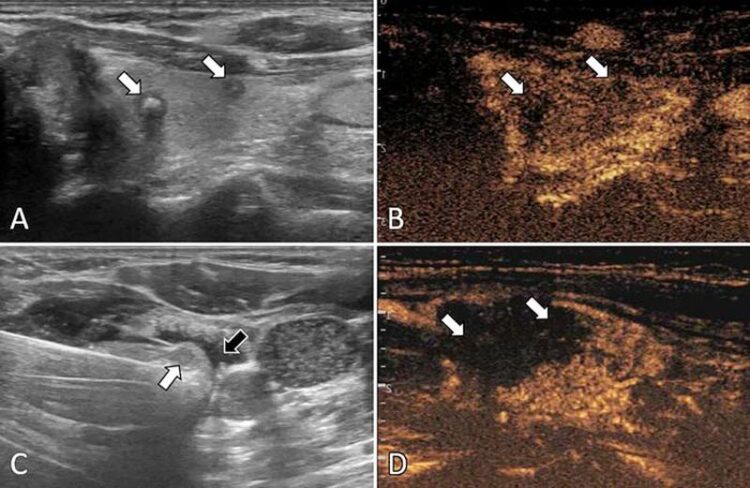Minimally invasive procedure may spare patients from thyroid surgery

Ultrasound (US) images in a 57-year-old female patient with multifocal papillary thyroid carcinoma (PTC). (A) Routine US scan shows two hypoechoic PTC nodules (arrows) in the left lobe. (B) Preablation contrast-enhanced US image shows hypoenhancement in the arterial phase (arrows). (C) Isolating fluid (black arrow) is used to protect the muscles beside the nodule (white arrow) during the ablation. (D) Postablation contrastenhanced US image shows no enhancement in the original tumor zone (arrows).
Credit: Radiological Society of North America (RSNA)
In a 10-center study, microwave ablation offered progression free survival rates and fewer complications than surgery in the treatment of a form of thyroid cancer known as papillary thyroid carcinoma (PTC), according to research published today in Radiology, a journal of the Radiological Society of North America (RSNA).
The most common type of thyroid cancer, PTC often presents with multifocality, meaning that two or more bumps or nodules (papillae) are found within the thyroid gland. The occurrence of multifocality within PTC cases is notably frequent, ranging between approximately 23.5% and 60%.
Multifocal PTC is often treated with surgical resection, where all or part of the thyroid is surgically removed. Thyroid surgery is not without side effects. It can impact the patient’s quality of life due to factors like scarring, the necessity of lifelong hormone replacement and potential complications, such as permanent hoarseness or impaired thyroid function.
Microwave ablation, a minimally invasive procedure that uses heat to destroy tumors, is currently under preliminary investigation and could be a viable alternative to surgery for some patients.
“This study marks the first multicenter comparative analysis between microwave ablation and surgical resection for multifocal papillary thyroid cancer,” said senior author Ming-An Yu, M.D., director of interventional medicine at China-Japan Friendship Hospital in Beijing, China. “These findings challenge traditional treatment paradigms and open new avenues for less invasive management strategies.”
Researchers looked at 775 patients with ultrasound-detected multifocal Stage I PTC treated with microwave ablation or surgery across 10 centers between May 2015 and December 2021. Propensity score matching—a technique used to compare groups with potentially different baseline characteristics—was performed, followed by comparisons between the two groups. Propensity score matching helps reduce bias by creating comparable groups, allowing for a more reliable assessment of the treatment effect.
After propensity score matching, 229 patients in the microwave ablation group and 453 patients in the surgical resection group were followed for a median of 20 months (range 12-74 months) and 26 months (range 12-64 months), respectively.
Microwave ablation was associated with similar progression-free survival rates to surgery (5-year: 77.2% vs. 83.1%) but with fewer complications and a greater potential for preserving thyroid function.
Microwave ablation resulted in less blood loss, shorter incision length, and shorter procedure and hospitalization durations. Permanent hoarseness (2.2%) and hypoparathyroidism (4.0%) were encountered only in the surgical resection group.
“Our study has shown that microwave ablation offers a promising treatment option for multifocal papillary thyroid cancer,” Dr. Yu said. “Additionally, microwave ablation is associated with fewer complications and can preserve thyroid function, thereby enhancing patients’ quality of life. This represents a significant advancement in the field of interventional thyroid cancer treatment.”
Dr. Yu notes that microwave ablation does not routinely include preventative ablation of lymph nodes. In surgical resection, preventative lymph node removal is a common practice. However, the results provide the first evidence that even without lymph node ablation, microwave ablation yielded comparable survival rates to surgical resection.
###
“Microwave Ablation versus Surgical Resection for US-detected Multifocal T1N0M0 Papillary Thyroid Carcinoma: A 10-Center Study.” Collaborating with Dr. Yu were Zhen-Long Zhao, M.D., Shu-Rong Wang, M.D., Gang Dong, M.D., Ying Liu, M.D., Jun-Feng He, M.D., Li-Li Shi, M.D., Jian-Qin Guo, M.D., Zhong-Hua Wang, M.D., Zhi-Bin Cong, M.D., Li-Hong Liu, M.D., Bei-Bei Yang, M.D., Chun-Ping Qu, M.D., Wen-Quan Niu, M.D., Ying Wei, M.D., Li-Li Peng, M.D., Yan Li, M.D., Nai-Cong Lu, M.D., and Jie Wu, M.D.
Radiology is edited by Linda Moy, M.D., New York University, New York, N.Y., and owned and published by the Radiological Society of North America, Inc. (https://pubs.rsna.org/journal/radiology)
RSNA is an association of radiologists, radiation oncologists, medical physicists and related scientists promoting excellence in patient care and health care delivery through education, research and technologic innovation. The Society is based in Oak Brook, Illinois. (RSNA.org)
For patient-friendly information on thyroid imaging, visit RadiologyInfo.org.
Journal: Radiology
Subject of Research: People
Article Title: Microwave Ablation versus Surgical Resection for US-detected Multifocal T1N0M0 Papillary Thyroid Carcinoma: A 10-Center Study
Article Publication Date: 2-Apr-2024
Media Contact
Linda Brooks
Radiological Society of North America
lbrooks@rsna.org
All latest news from the category: Medical Engineering
The development of medical equipment, products and technical procedures is characterized by high research and development costs in a variety of fields related to the study of human medicine.
innovations-report provides informative and stimulating reports and articles on topics ranging from imaging processes, cell and tissue techniques, optical techniques, implants, orthopedic aids, clinical and medical office equipment, dialysis systems and x-ray/radiation monitoring devices to endoscopy, ultrasound, surgical techniques, and dental materials.
Newest articles
Faster, more energy-efficient way to manufacture an industrially important chemical
Zirconium combined with silicon nitride enhances the conversion of propane — present in natural gas — needed to create in-demand plastic, polypropylene. Polypropylene is a common type of plastic found…

Energy planning in Ghana as a role model for the world
Improving the resilience of energy systems in the Global South. What criteria should we use to better plan for resilient energy systems? How do socio-economic, technical and climate change related…

Artificial blood vessels could improve heart bypass outcomes
Artificial blood vessels could improve heart bypass outcomes. 3D-printed blood vessels, which closely mimic the properties of human veins, could transform the treatment of cardiovascular diseases. Strong, flexible, gel-like tubes…





















